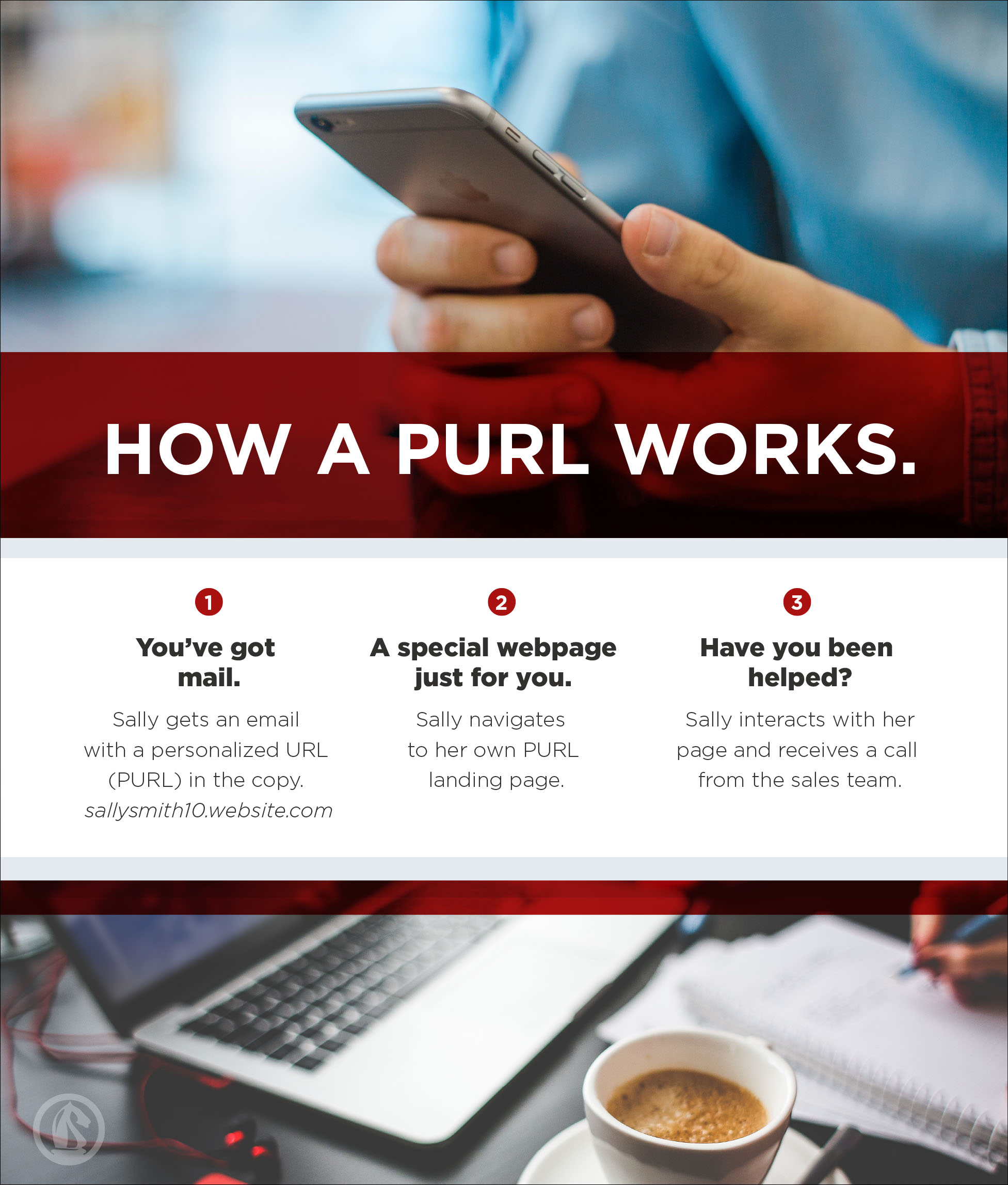
Marketing White Paper
What’s a PURL?
You know the scene—you’re sitting in a meeting with this super sleek, cutting-edge integrated marketing team and everyone’s talking about pearls.
You’re smiling and nodding but you’re secretly thinking, “What’s a pearl? Am I the only one who doesn’t get why these people are talking about jewelry and personalized marketing content in the same breath?”
So (under the table, on your phone) you Google “what’s a pearl?”
And since you know these people aren’t the knitting type, you quickly find out that they’re referring to a PURL—a personalized URL.
It’s Not a Pearl or a Purl—It’s a PURL
For the people who don’t live and breathe marketing and advertising and who do think necklace when they think pearl, a PURL is a website address that has some type of personally identifying information within the URL.
A PURL can read like this:
- sallysmith10.websitename.com
- websitename.com/sally.smith10
How a PURL Campaign Works

A PURL typically pairs with an email or direct mail marketing campaign.
For example, if you add a PURL to your email campaign, your lead will receive an email that says something like, “Hey Sally, we’ve got something special for you! Visit sallysmith10.websitename.com to discover what’s in store.”
When Sally receives an email personalized with her name and a link to her very own webpage, she’s intrigued. When she clicks to her webpage, she reads, “Thanks for joining the movement Sally! We’d love to see you at our A-List-only sneak-peek event.” On her webpage, you’ve added fields where she can provide information on herself: name, address, favorite color—whatever you need to know to help you find the right product or service for Sally.
The data Sally enters feeds directly into your integrated CRM. Your sales team receives notice of her interaction with the PURL, sees the new data points, and contacts her to follow up. Armed with Sally’s new data imported into the CRM, your sales team can ask highly relevant questions and deepen the relationship by making Sally feel engaged and connected.
Why Should You Use a PURL in an Integrated Marketing and Advertising Campaign?
PURLs are used for three reasons:
- To engage prospects via personalization
- To gather key data on prospects
- To track and analyze the results of an advertising campaign
Using PURLs to Engage Your Audience
In marketing, anything you can do to create meaningful engagement with your prospects is extremely valuable. PURLs are one means of gently engaging your prospects.
Wouldn’t it be cool to have your own webpage? Sally thinks so. When she saw that PURL in her email, she felt kinda’ special, so she clicked to her page.
Marketing is all about developing relationships with your leads. Good sales people don’t ram a product down a prospect’s throat, they engage with prospects to figure out if their product or service is a good fit for the prospect.
What you’re really doing with a PURL campaign is gently drawing in a prospect and deepening both the prospect’s relationship with your business and their connection to your product or service.
Gather Key Data on Prospects Using PURLs
When your lead opens the marketing email you sent and clicks the link to visit their PURL, they are presented with a webpage including information on your brand.
You have the prospects attention—use it wisely.
Be sure your imagery and copy appeal to your prospect so they feel comfortable with the next step—telling you about themselves. Gathering key data on your prospects is a major feature of PURL campaigns. Strategize about a few simple things they can tell you that will help you give them what they need.
A UX designer can help create a comfortable experience for your prospects and make it very easy for them to give you information—think simple questions, dropdowns, wide open spaces, appealing graphics, and a general air of professionalism.
If it makes sense within the client’s overall integrated marketing and advertising strategy, FabCom will execute a PURL campaign. Our agency helped a tech-centered university foster relationships with prospective students using PURLs. Below is an example of a PURL landing page that prompts the prospective student to input intent-based information.

The data you gather on your prospects using a PURL must go somewhere. Be sure to integrate your CRM with the PURL campaign so the data is saved and useful as you continue to engage with the prospect.
In the example above, the data gathered from the PURL landing page enables the university’s admissions team to have a fuller picture of the student and provide personalized follow up.
Find Peace by Tracking ROI
Because PURLs follow your leads from click to click, they can help you make smart, forward-thinking decisions based on hard data.
Does the thought of dumping a bunch of money into marketing and advertising make you physically sick? All that cash. All the blood, sweat, and tears to make all that cash. And then you’re supposed to just toss it all in the air and hold your breath?
Too many businesses do their marketing and advertising that way.
Don’t be that business.
When you set up any kind of advertising campaign you must meticulously integrate analytics into every possible facet of the campaign. If you don’t, you can’t track your return on investment.
When you’re not tracking performance, you’re leaving yourself wide open to failure and wasted marketing dollars.
Without closely watching your campaign, you can’t adjust and pivot. No one is omniscient—no one knows exactly how people will react to your ad campaign. Continuous monitoring needs to be enabled to keep the campaign hitting your targets.
Do you Still Need Analytics If You Use PURLs?
Using PURLs is a great way to track if your advertising campaign is working, however, PURLs have limitations on what they can track. Even with the data tracking inherent to PURLs, you still need additional analytics. You want to layer deep analytics over your PURL pages to track things like:
- How long the prospect spent on the page
- How many times they visited the page
- Where your visitors are located
When you have a team of strategists and analysts keeping their finger on the pulse of your spend vs. your results, you remove the fear surrounding marketing and advertising and make key business decisions with confidence.
11 Steps to Creating an Integrated PURL Campaign
- Get your hands on a hefty list of leads
- Create an email marketing and/or direct mail piece
- Choose a PURL generator
- Include the PURL for each prospect in your email or direct mail campaign by merging your file of leads
- Integrate your CRM with the campaign
- Set up analytics listening
- Hit send
- Follow up with prospects who used the PURL
- Remarket with highly relevant content
- Follow up again
- Close the deal
How Do You Add PURLs to Your Email or Direct Mail Campaign?
As noted above, step three to creating a PURL campaign is to choose a PURL generator. There are two options for adding PURLs to your ad campaign:
Do it Yourself PURLs
- If you’re the DIY type, you can run a PURL campaign yourself using a few different services. You need a service to gather a lead list, a service to generate your personalized URLs, and an email provider. You need to write the copy for the email and landing page, create graphics to make it all look polished, integrate the PURL data with your CRM and analytics, personally follow up with the leads, and develop a strategy to continue the relationship.
Hire it Done with a PURL Service
- If you’re not a marketing and advertising expert, you can hire an integrated marketing and advertising agency to take care of all the nitty gritty details. You’ll just want to make sure that the firm has the capability to execute on all elements of the campaign under the umbrella of your overall marketing strategy. For instance, some agencies just do your branding but not your email marketing or variable data printing. Other agencies can’t provide the coding needed to integrate the prospects’ webpage activity into your CRM and your analytics. Conduct thorough research, ask questions, and make sure the agency runs your PURL campaign under the umbrella of your overall marketing and advertising strategy.
Close the Loop to Get Strong ROI from PURLs
Developing a PURL campaign should be seen as one piece of your overall marketing and advertising strategy. To ensure you’re not wasting your advertising budget, don’t just hit send and then sit back and expect your bank account to balloon. Once you’ve begun your PURL campaign, you’re just getting started. To close the loop and see excellent return on your investment, you must continuously attend to the following:
- Fostering your relationship with engaged prospects
- Remarketing to prospects wherever they spend their time
- Analyzing campaign analytics
What’s the Cost of a Good Set of PURLs?
Technology changes daily so you’ll have to do your research, but for the most part, you can run a simple DIY PURL campaign for as low as $300. Note that this PURL generator fee does not include these elements necessary for an effective campaign:
- strategy conception
- lead generation
- copywriting
- graphics creation
- database feed
- CRM integration
- sales scripts
- follow up campaign
PURLs can be an excellent addition to your overall integrated marketing and advertising strategy. A robust, comprehensive, high-ROI strategy executed by a team of experts ensures your brand gets the attention it deserves, and you get the time and returns you need to focus on what you do best.
To Recap:
When done right, integrated correctly, and developed as part of an overarching marketing and advertising strategy, PURLs create meaningful connection with prospects, gather prospect data, enable quality tracking of key data points, and help you meet your business goals.